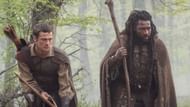Robin Hood season 1 episode 4 shows how Robert’s first major heist shapes the direction of his life and establishes his transformation into Robin Hood. The episode concludes with Robert leading a coordinated robbery of the Bishop’s bounty carriage, which is money intended to fund the expanding manhunt against him and his growing band.
The plan succeeds, but the cost is heavy, and the choice he makes afterward defines the identity he begins to carry. By allowing the Bishop to walk away instead of killing him, Robert signals the beginning of a larger resistance. Episode 4 uses this turning point to illustrate how a single operation becomes the foundation of a legend.
Disclaimer: This article contains major spoilers for the show. Read at your own discretion.
What happened in Robin Hood season 1 episode 4?
 Robin Hood season 1 (Image via Facebook/MGM+)
Robin Hood season 1 (Image via Facebook/MGM+)Robin Hood season 1 episode 4 centers on Robert’s decision to intercept the Bishop’s bounty carriage. Friar Tuck provides the key information: the Church and Nottingham plan to split the cost of hiring two hundred soldiers for the pursuit. Stopping the transport weakens the manhunt and gives Robert’s group time to stabilize their position in the forest.
When the outlaws block the road, they expect a small escort. Instead, a large group of armed guards arrives, forcing a violent confrontation. Mary and Henry Miller lose their lives, and the remaining outlaws fight to survive the ambush.
During the chaos, Spragart calls Robert “Robin Hood” for the first time. The name becomes a symbol of the group’s shift from accidental fugitives to organized resistance.
Why does Robert let the Bishop escape in Robin Hood season 1 episode 4?
Robert’s decision to release the Bishop defines the ending of Robin Hood season 1 episode 4. Tuck and the others want to continue the fight, but Robert directs the Bishop to return to Nottingham with a message: the outlaws are growing in number, and force alone will not stop them.
The group has recently lost two members, yet Robert avoids turning the encounter into retaliation. Sparing the Bishop shifts the focus from violence to strategy by targeting the resources that support Nottingham. Reducing funds limits the Sheriff’s reach, and removing fear weakens his influence.
The scene also highlights Robert’s leadership. When Tuck confronts the Bishop, Robert stops the escalation and orders his release. Allowing the Bishop to leave ensures that news of the heist and the outlaws’ renewed momentum reaches Nottingham without delay.
How does Robin Hood season 1 episode 4 develop the outlaw band’s identity?
Robin Hood season 1 episode 4 builds the group that will one day be known as the Merrymen. The episode begins with the aftermath of Aaron Huntington’s death. Little John mourns the loss of his dog. Robert struggles with guilt, while Ralph processes the weight of her actions. Their emotional state sets the tone for how quickly the group needs direction, food, and structure.
The arrival of Friar Tuck becomes a turning point. Tuck’s criticism of the Bishop exposes the shared hardship between poorer Normans and Saxons. This shifts Robert’s perspective. He sees that their opposition is not rooted in culture alone but in power and corruption.
Spragart and Mary arrive soon after. Their addition expands the group’s abilities but also introduces the first casualties of their new identity. The deaths of Mary and Henry Miller during the heist show that the transition from fugitives to organized rebels carries risks. It also sets the emotional stakes for future missions.
By the end, the group has a name, a cause, and a collective sense of responsibility. Episode 4 marks the moment the outlaw band begins to function as something larger than a group surviving in the forest.
Robin Hood season 1 episode 4 uses its ending to define Robert’s rise from fugitive to symbol. The heist ends with the bounty stolen, casualties within the group, and the Bishop allowed to escape with a message for Nottingham. The moment Robert is first called “Robin Hood” signals how his identity is shifting in the eyes of both his allies and his enemies.
Why did you not like this content?
- Clickbait / Misleading
- Factually Incorrect
- Hateful or Abusive
- Baseless Opinion
- Too Many Ads
- Other
Was this article helpful?
Thank You for feedback
Edited by Bea Melisse Ibañez

.jpg) 1 hour ago
1
1 hour ago
1
 English (US)
English (US)